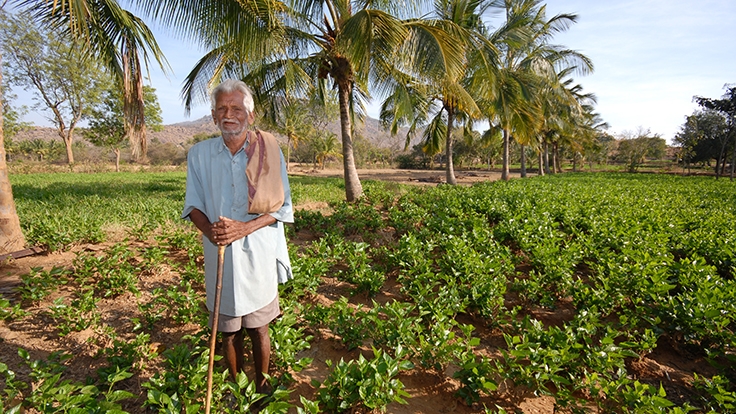Farmer Gundappa's wizened old face beams with pride as he stands amidst the young mulberry trees that shoot up from the once-parched earth. “Although the past few monsoons have brought very little rain, I haven’t been worried at all,” he says, pointing to an open well at the corner of his field. “I now have enough water in my well to keep my fields green,” he says confidently.
Three consecutive years of drought had dried up the water in local wells, making it difficult for Karnataka's farmers to grow anything. The interminable wait for an unpredictable monsoon has long been the lot of farmers with unirrigated lands on this dry dusty plateau stretching across much of southern India.
Now, a small check dam across a nearby stream has given Gundappa's farmlands a new lease of life, and the old farmer a new-found sense of security. The cement and stone check dam –looking somewhat like a speed breaker - has slowed the seasonal torrent of water that rages downstream during the monsoon rains. This has allowed the water to seep slowly into the ground, recharging the farmer's long-dry well.
The driving force behind this rural rejuvenation is the Karnataka Government’s innovative watershed development project – known locally as ‘Sujala’ – and supported by a World Bank credit of $100.4 million.
With water readily available, Gundappa has planted big-leafed mulberry trees on land that could barely yield coarse grains till not so long ago. Gundappa plans to use the mulberry leaves to raise silkworms for the region’s thriving silk industry - the area is known for ‘milk and silk’- and feed the remainder to his cows.
Conserving soil and recharging groundwater
The check dam is one of the many measures that are being taken to revitalize farmlands in seven of the driest and most drought-prone districts of Karnataka, India’s driest state after Rajasthan.
Till now, without a reliable source of water, most of the region’s farmers could grow crops only during the monsoon rains, and that too, mostly the few coarse grains such as ‘ragi’ and ‘jawar’ that are suited to these withered soils. Left with no productive work for the rest of the year, many small farmers regularly migrated to nearby towns in search of poorly paid jobs as manual labor.
But now, the project is helping communities to change all that. Farmers are raising a variety of strategically placed bunds to retain rain water, arrest soil erosion, and prevent the silting up of water courses downstream.
Farm productivity is rising
As a result, groundwater tables have risen in areas where the project has been completed. With more water available, the growing season is longer, crop yields have risen, and farmers are able to cultivate two or more crops a year. Better productivity of lands is raising farmer incomes substantially.
A new method of growing paddy – the Madagascar method known locally as Jalashri - which uses far less water and fewer seeds, yet gives higher yields, is being introduced.
The cropping pattern has also changed. Farmers are moving away from subsistence farming by growing a wider range of higher value cash crops suited to local conditions.
The area under horticulture has also increased. In Haveri district - the driest district in Karnataka – and elsewhere, mango saplings, sapota, custard apple and pomegranate are taking root on once-barren lands. Mulberry plantations are increasing to feed the region’s growing silk industry. As a result, migration into towns for work has dropped noticeably.

